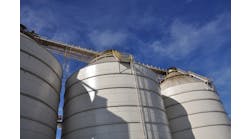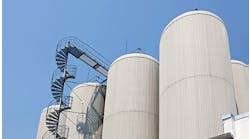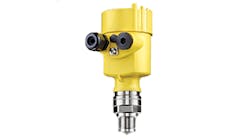This Control Talk column appeared in the April 2019 print edition of Control. To read more Control Talk columns click here or read the Control Talk blog here.
Greg: It’s not well recognized that a sensitive level measurement can be extremely valuable. For inventory, a fraction of an inch change in level in a large-diameter tank is a lot of material. For closure of material balances, these seemingly small changes in level can make a huge difference in accounting and in process control of some key unit operations. For crystallizers, evaporators and reactors, tight residence time control depends upon an accurate level measurement. Many multi-effect evaporators measure and control the product density in the last stage by manipulating a product or feed flow. These multi-effect evaporators depend upon tight level control to make sure changes in flow in and out of each effect are equal. For distillation columns where the distillate receiver level controller manipulates reflux flow, extremely tight level control enables much better temperature control, particularly through inherent internal reflux control. Tight level control translates manipulated changes in distillate flow by the temperature or composition controller to the necessary equal changes in reflux flow. While ratio or feedforward control can help here, changes in overhead vapor flow are unmeasured and the correction by temperature or composition controllers is playing catch up. Translation of these unmeasured changes in overhead vapor flow to reflux flow by tight level control enables internal reflux control. Tight level control self-corrects for decreases in upper column temperature (e.g., blue northerner rain storms) that cause a sudden large decrease in vapor flow and upset to the column. When distillate receivers are horizontal vessels, level sensitivity is even more important because the cross sectional area is so large.
Great level sensor sensitivity goes to waste for residence time control and material balance control if the level controller gain is not set high enough. In most cases, the level controller gain can be more than 100. Because users are uncomfortable with such high gains, the gain is often two orders of magnitude too low, resulting in a reset time two orders of magnitude too small. The product of the PID gain and reset time must be greater than twice the inverse of the open loop integrating process gain, or slow rolling oscillations will develop. Because users are taught that oscillations are caused by too high a PID gain, the gain setting is reduced, making the problem worse (amplitude larger and decay slower). The Control Talk blog “PID Options and Solutions - Parts 2 and 3” items 2-11, 2-12 and 3-1 note this common problem.
The most predominant level measurement uses a differential pressure (DP) transmitter. The actual level, of course, depends upon density. A second DP whose high and low connections are always submersed or a Coriolis meter in a recirculation line can be used to measure density to correct the reading, but the DP sensitivity is not great. The accuracy seriously deteriorates due to problems and limitations of impulse lines, purges and capillary systems. The measurement is vulnerable to impulse lines having a change in density due to a change in composition or phase, as noted in the Control Talk column “Prevent pressure transmitter problems.” While purges and capillary systems can eliminate impulse lines, these have their own problems, as described in the subsequent Control Talk column “Your DP problems could be a result of improper use of purges, fills, capillaries and seals.”
We have a situation for level similar to last month’s for mass flow, where Coriolis meters had an order of magnitude better accuracy, much greater reliability and much less vulnerability to installation problems. The level measurement is radar. Like Coriolis, radar doesn’t depend on density (and thus associated changes in composition) and, while the hardware cost is higher, the installation cost, and especially the maintenance cost, is less. If you include the improvement in process monitoring and control, the return on investment is a no-brainer.
To help us get sensitive to sensitive level measurement, we gain the insight and knowledge offered by Jeff Blair, offer manager for level, Schneider Electric.
Jeff: Thank you for inviting me to Control Talk, Greg. It’s an honor to be here. I enjoyed reading your material along with items from Hunter Vegas and many others.
Greg Shinskey said in his article, “The Enigma of Liquid-Level Control,” that “level can either be one of the easiest processes to control, or one of the most difficult.” While it may sound a bit vague, it’s very true. Shinskey was not only referring to the process but the level measurement technology. A simple dipstick in your car to check the oil level is a pretty easy level measuring device. When tanks are filling, emptying and potentially mixing at a certain rate with different fluids—that’s a much bigger challenge for a level instrument!
Colleagues Mike Tjemmes, Justin Rechner and I were tinkering with the idea of writing a white paper with a working title, “You Give Radar a Bad Name.” It never came to fruition. Most of the free space radar (FSR) and guided wave radar (GWR) applications we see work flawlessly and get rave reviews. However, a small number of radars are misapplied or not installed properly. So, we’ve been on an educational tour to help teach the operators, technicians and engineers about proper installation procedures and how to get the best signal return. It’s for reasons like these that there has been a trend for manufacturers to offer additional field services (including startup services) for radar. FSR and GWR are actually easier to commission and use than most instruments, as long as the end user follows proper vendor instructions and/or has a rep or vendor either onsite or on speed dial/Facetime/Skype to help.
Greg: What are the most challenging FSR and GWR applications, and what are some of the ways they can be measured successfully?
Jeff: We always like to start with the tough stuff. When we think of challenging level applications, we tend to dwell on liquid properties, like density, which affect DP level and buoyancy level, but have no effect on radar. That’s one of radar’s biggest advantages. Radar is very robust with no mechanical parts, but some of the measurement challenges it may have include:
- Measuring through foam and heavy vapors—GWR is preferred for foam and vapor applications, because the signal stays in contact with the cable or probe. So, it generally “sees” through the media to find the liquid level. FSR may work with some types of foam and vapors, but it is often a trial-and-error application. Its signal may lock onto the top of the foam as the level, or get absorbed by the vapors. Low-frequency FSR (10-24 GHz) generally has a better success rate than higher-frequency (80 GHz) radar due to larger wavelength that doesn’t get absorbed as easily.
- High viscosity liquids—FSR is preferred, as it won’t contact the liquid. GWR also works, but a viscous liquid may have potential to build up on the probe or cable and require periodic cleaning.
- Abrasive and corrosive liquids—For both types of radar, proper material selection is the key. FSR is preferred, because it is non-contact. GWR may require an exotic metal or material probe such as Hastelloy-C.
- Agitated and turbulent processes—Both types of radar may have difficulties with attempted direct level measurement of agitated surfaces. Using a GWR with a coax antenna often offsets agitation effects. Stilling wells (like a large coax antenna) or a bypass chamber may be used with FSR to remove them from the agitated liquid and measure the level of a “calmer” surface.
- Interface—GWR can measure interface if certain conditions are met, which include a difference in dielectric constants (Dk) of the fluid and lack of large emulsion layers. Ensure manufacturer’s guidance is followed.
- Applications with fluctuating dielectric constant (Dk)—With both types of radar, plan your application around the liquid with the lowest expected Dk. Using that worst-case scenario will ensure good measurement of other liquids with higher Dk. GWR is preferred here, as it usually allows better measurement of low-Dk fluids.
If end users and engineers look at the FSR market today, they will find myriad choices and each has its own strengths and weaknesses. FSR features many different radar frequencies (10 GHz, 24 GHz and 80 GHz), and two different types of technology—frequency-modulating continuous wave (FMCW) and pulse.
Greg: What equipment and process application details do you need to know to correctly specify and install FSR and GWR?
Jeff: When selecting a radar measurement, the best thing to do is to gather the criteria of process temperature, process pressure, expected dielectric constant (Dk), material requirements, available tank connections and economics. Next, work with your favorite representative or manufacturer to help narrow the choice of applicable radar models. They can guide you on available models and also help select special models that can perform interface measurement (GWR) or tolerate high temperatures and pressures for applications such as steam drum measurement.
All application parameters are important to make sure the correct radar is selected and that it performs for the lifecycle of the process. Besides ensuring a Dk of 1.1 or higher (1.5 preferred), the other most important thing to consider when selecting radar is to ensure proper selection of the cable, rod or coaxial probe (GWR) or antenna (FSR). The reason is that those items and their design and dimensions have a large part in determining the overall maximum measurement length, beam angle (FSR only), and temperature and pressure limitations. A close runner up to the antenna selection is the proper choice of the physical installation location (i.e., what distance from the tank wall, ensuring location is away from center of tank and any filling nozzles or streams) on top of the tank, vessel, sump pit or stilling well. The goal of proper physical location of the radar is to eliminate potential obstacles and give the radar the best possible chance at return signal. There are fewer constraints and restrictions when choosing an installation location for GWR as the microwave energy always stays within a radius of the probe.
Greg: What are the installation requirements you need to carefully address for FSR and GWR?
Jeff: The beauty of both types of radar is their simple installation techniques compared with other types of level instrumentation. There are no requirements for process tubing runs that are often required for DP level applications. Regarding GWR, pay attention to ensure you have enough overhead clearance to install a rod or coax unit. It’s no different than ensuring overhead coverage when installing a capacitance probe or a magnetostrictive instrument. And some of the probes come in segments, so several short pieces may be assembled together rather than a long 10- or 20-foot rod. Cable antennas for GWR may need to be secured to the bottom of the tank. If that’s the case, there may be some potential for confined space permits. FSR is a bit simpler because it is non-contact; there is no probe or cable that extends down into the liquid.
Once those items are accounted for, both FSR and GWR simply are screwed into their process connections with the face oriented in accordance with instructions.
Installing radar when the tank is empty is advised. This allows the radar software to take a snapshot of the tank and identify any obstacles (e.g. baffles, ladders) that may be interpreted as false level reflections. The snapshot or tank mapping procedure allows the user to blank out potential false echoes. It’s worth noting that high-frequency (80 GHz) types of FSR have a narrow radar beam that’s often able to avoid seeing obstacles and potential disturbances, eliminating the need to map them out.
Greg: What do you need to know to correctly install FSR and GWR?
Jeff: In radar, the measurement is inferred from distance, like how level is inferred from head pressure when using DP level. The data needed are three pieces of information:
- The tank height—from the process connection of the radar to the tank (where the radar signal generates) to the tank bottom.
- The 4 mA or 0% level—this should normally be located at an offset from the very bottom of the tank.
- The 20 mA or 100% level—this should be located below the flange and allow room for the radar dead space. Each type of radar requires a small amount of buffer space either below the process connection or the horn (FSR only).
Greg: How do you minimize maintenance requirements for FSR and GWR?
Jeff: It’s all about the installation. Under normal circumstances, no maintenance is necessary like there would be with a mechanical device or a DP cell that may require cleaning of process lines. If the radar converter or head unit suffers physical damage, it’s possible to leave the process connection (e.g. 3-in., 150 psi ASME flange) and attached antenna in place, and just replace the damaged portion.
Greg: How do you verify performance and diagnose FSR and GWR problems?
Jeff: Vendors often use stories of accidents at Buncefield or Texas City as examples of why to buy and properly maintain new level instruments. They’re good examples, as both these potentially preventable accidents featured level instruments that were not properly maintained, and the devices in use may not have been the best instrument(s) for the applications. Most modern FSR and GWR incorporate advanced diagnostics to consistently ensure things are running properly. Diagnostics consistent with NAMUR Recommendation NE 107 (Self-Monitoring and Diagnosis of Field Devices) are popular and offer consistent real-time feedback to the end user regarding maintenance required, failures or anything that’s out of specification. Taking advantage of the available diagnostic data coupled with a good installation in accordance with your vendor’s guidance is the best way to keep radar performing to its best potential.
Greg: When would you use ultrasonic instead of radar level measurements?
Jeff: Cost-conscious consumers often chose ultrasonic. Ultrasonic transmitters using sound waves were about half the cost of radar, and like radar, they perform flawlessly if they’re applied and installed properly. Now, in general, the average price of process FSR and GWR have come down so that the price delta between radar and ultrasonic closed. Price being nearly equal, most users opt for radar as it can handle higher temperatures and pressures. Now, ultrasonic measurements’ primary advantage is that its unaffected by Dk. One of the drawbacks to ultrasonic used to be the buildup of condensation on the transducer face. Recently, there’s been some advancement in that field where some ultrasonic measurements are better able to shed condensation droplets to make a reliable measurement.
Greg: What are some final words of wisdom for best FSR and GWR applications?
Jeff: We all get into trouble when we pick the radar style (e.g. Just throw a guided wave on there!) before we examine the application in depth and gather the necessary details.
- Unless you’re working with an identical process, please fill out the detailed vendor application information sheets. They’re all tedious but it helps ensure you and your supplier are in agreement before you install the radar.
- Work with your vendor to customize a radar training program. Whether you’re specifying or installing, vendors can customize a program to ensure you know how to apply their product. In-person training is preferred but when that’s not practical, self-learning online is a runner-up.
- Update your approved vendor list (AVL) to take advantage of radar technology for your next application—if you are hesitant to try it out in a process, try a non-critical loop or give them a shot in a test lab or pilot plant.
- Work with a vendor that will allow a trial. Despite radar becoming one of the dominant level technologies because of its versatility, there are still some applications that are not ideal and would benefit from a trial.
- Coax antennas (GWR only), stilling wells and bypass chambers may help less than ideal process conditions.
Greg: For more on what to look for,check out the Control Talk blog, “Checklist for Best Radar Level Measurement Performance”and the following references from Jeff:
- Chemical Processing, June 2011 “Make the Most of Radar”
- Control, January 2013 “Matching Level Applications to The Correct Level Technology”
- Control, June 2012 “Radar Love”
- Foxboro Pub 413-5, Circa 1972 “The Enigma of Liquid-Level Control”
- Flow Control, February 2017 “Selecting the Right Frequency For Radar Level Measurement”
- Honeywell, April 2010 “Applying Buncefield Recommendations and IEC61508 and IEC 61511 Standards to Fuel Storage Sites”
- Emerson, 2018 “The Engineer’s Guide to Level Measurement 2019 Edition”
- Endress+Hauser, July 2017 “Frequency and Antenna Selection Effects on Accuracy of Free Space Radar”
- Krohne Academy, accessed March 1, 2019 “Radar Level Measurement”
- Krohne Whitepaper, accessed March 1, 2019 “Frequency-Modulated Continuous-Wave (FMCW) Radar Level Measurement Systems”
- Process Industry Practices, August 2006 “PIP PCCLI001 Level Measurement Design Criteria”
- Schneider Electric, November 2018 “Level Instrumentation Selection Guide”
- Schneider Electric, July 2016 “LR01 Free Space Radar Level Meter—Handbook”
- Schneider Electric, July 2017 “LG01 Guided Wave Radar Level Meter—Handbook”
- Sensors Online, March 2011 “Ultrasonic Transmitters vs. Guided-Wave Radar for Level Measurement”
- Vega, November 2016 “Measurement Impossible: Three level measurement challenges in small vessels and how radar can overcome them”
(10) The operators are fuming about the foam in the vent.
(9) Level? It’s anybody’s guess.
(8) Heat-trace the heck out of the DP wet leg.
(7) Wet leg or dry leg, who knows?
(6) Crank up the purge rate till we always get a constant reading.
(5) Process density? Isn’t the specific gravity 1?
(4) Just let the capillary hang out.
(3) The DP transmitters are mounted near the instrument shop for faster maintenance.
(2) Get a control valve with the greatest capacity and smallest leakage.
(1) If the level loop is oscillating, decrease the level PID gain.





